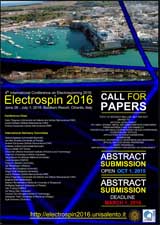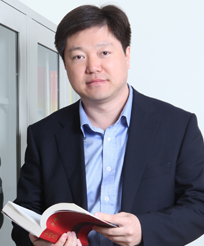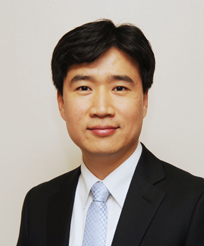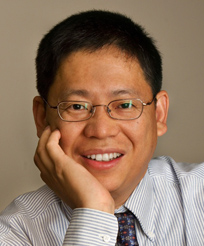|
Dr. Bin Ding received his PhD degree from Keio University in Japan in 2005. After two years of post-doctoral research in Keio University (2005-2007) and a year in the University of California at Davis (2007-2008), he started his career as a Professor of Materials Science in Donghua University in 2008. Now, he is the Vice Dean of College of Textiles at Donghua University. He discovered the design and fabrication of 1D flexible ceramic nanofibers, novel 2D nano-nets, and 3D nanofibrous aerogels for applications of high-temperature insulation, air filtration, waterproof and breathable fabrics, oil/water emulsion separation, sound absorption, etc. Dr. Ding has authored and co-authored 134 peer-reviewed journal papers, edited a Chinese book “Electrospinning and Nanofibers” (China Textile & Apparel Press, China, 2011) and an English book “Elctrospun Nanofibers for Energy and Environmental Applications” (Springer Publishing, Germany, 2014), co-edited 11 volumes of books on electrospun nanofibers, and held over 30 approved patents. The honors he has received include the Distinguished Achievement Award of The Fiber Society (USA) in 2014, Excellent Young Scientist Foundation of National Natural Science Foundation of China (NSFC) in 2013, New Century Excellent Talent of Chinese Ministry of Education in 2011, and “Dawn” Program of Shanghai Education Commission in 2010. |
||
|
Professor Il-Doo Kim Dr. Il-Doo Kim is an associate professor in the Department of Materials Science and Engineering (DMSE) at KAIST. He received PhD degree (2002) in DMSE from KAIST. From 2003 to 2005, he was postdoctoral fellow with Prof. H. L. Tuller at MIT, where he worked on low-voltage ZnO-based thin film transistors, Si-integrated microphotonics, and metal oxide-based chemical sensors. In 2005, he returned to Korea Institute of Science and Technology (KIST) as a senior research scientist. Since that time, he has established an electrospinning route for producing multi-component ceramic nanofibers. The key electrospinning techniques have been patented and successfully licensed to 4 different companies for commercialization of environmental chemical sensors and Li-ion batteries. He came to KAIST as a faculty member of DMSE in 2011. His group (Advanced Nanomaterials and Energy Lab.) is focused broadly on novel synthetic methods to produce various nano-building blocks such as highly porous nanofibers and nanotubes via electrospinning. He has participated in writing 5 book chapters, published 139 peer-reviewed journal articles (including 19 cover-featured articles), and held 145 international patents. He had served as a chairman at the International Conference on Electrospinning (Electrospin 2012) in Jeju, Korea, in 2012. Currently he is serving as a deputy editor of the Journal of Electroceramics and an associate member of Korea Academy and Science since 2012. |
||
|
Professor Tong Lin received his PhD degree in physical chemistry from Chinese Academy of Sciences (CAS) in 1998. After several years of postdoctoral research in China, Australia and USA, he joined Deakin University in 2003, and has worked as Research Academic, Senior Research Fellow, Associate Professor, and now Personal Chair (Chair Professor in Fibrous Materials). He has been an active researcher to contribute to the development of electrospinning techniques and novel applications of nanofibers. Prof. Lin has published over 180 peer-reviewed journal articles, 26 books/book chapters, and 70 other papers. He has also been awarded the Australian Research Council (ARC) Future Fellow and Fellow of the Royal Society of Chemistry (RSC, UK). |
||
|
Professor Darrell Reneker Professor Darrell Reneker began working on polymer physics at the Dupont Company in 1959, after receiving his PhD degree in Solid State Physics from the University of Chicago for research on electrons in semimetals. He holds a BSc degree in Electrical Engineering from Iowa State University. In 1969 he joined the National Institutes of Standards and Technology (NIST) and became manager of the Center for Materials Science. He served as Executive Secretary of the Committee on Materials of the White House Science Office. He came to the University of Akron as Professor of Polymer Science and Director of the Institute of Polymer Science of the University of Akron in 1989. He discovered a family of crystallographic defects that transport and rotate a polymer molecule along its axis, in a chain folded polymer crystal, and stimulated world-wide interest in the use of nanofibers made by electrospinning. His awards include the Silver Medal Award from the Department of Commerce and a Senior Executive of the US Civil Service. At the University of Akron, he was awarded Outstanding researcher (2002), Order of the Phoenix (2009), and Distinguished Professor (2011). |
||
|
Professor Eyal Zussman Dr. Eyal Zussman is the Winograd Professor in the Department of Mechanical Engineering at the Technion – Israel institute of Technology. He holds a DSc degree from the Technion in mechanical engineering. He held postdoctoral appointment at Technical University in Berlin, Germany. Since joining the faculty at the Technion, he has served as Director of the NanoEngineering Group. His group research is in the area of molecular engineering of soft matter, in particular the development of process-structure-property relationships, through the use of simulations and experiments, and the development of functional electrospun fibers. He was Visiting Professor at the Northwestern University (2003), and at the National University of Singapore (2010-2015). He has published over 130 peer-reviewed journal articles. |
||
|
Dr. Younan Xia is the Brock Family Chair and Georgia Research Alliance (GRA) Eminent Scholar in Nanomedicine at the Georgia Institute of Technology. He holds appointments in three academic units: The Wallace Coulter Department of Biomedical Engineering, School of Chemistry and Biochemistry, and School of Chemical and Biomolecular Engineering. He received a B.S. degree in chemical physics from the University of Science and Technology of China in 1987, a M.S. degree in inorganic chemistry from University of Pennsylvania (with Professor Alan G. MacDiarmid) in 1993, and a Ph.D. degree in physical chemistry from Harvard University (with Professor George M. Whitesides) in 1996. His group has invented a myriad of nanomaterials with well-controlled sizes, shapes, structures, compositions, and properties. These nanomaterials have found use in applications related to plasmonics, optical sensing, electronics, photonics, photovoltaics, display, catalysis, fuel cells, and biomedical research. As an example, his technology on silver nanowires has been commercialized by Cambrios for the manufacturing of flexible, transparent, and conductive coatings sought in applications such as touch screen, flexible electronics, and photovoltaics. Xia has co-authored more than 620 publications in peer-reviewed journals, together with a total citation of more than 96,000 and an h-index of 160. He has been named a Top 10 Chemist and Materials Scientist based on the number of citation per publication. He has received a number of prestigious awards, including American Chemical Society (ACS) National Award in the Chemistry of Materials (2013), NIH Director's Pioneer Award (2006), David and Lucile Packard Fellow in Science and Engineering (2000), NSF CAREER Award (2000), and Alfred P. Sloan Research Fellow (2000). More information can be found at http://www.nanocages.com. |





 Professor Bin Ding
Professor Bin Ding
 Professor Tong Lin
Professor Tong Lin
 Professor Younan Xia
Professor Younan Xia